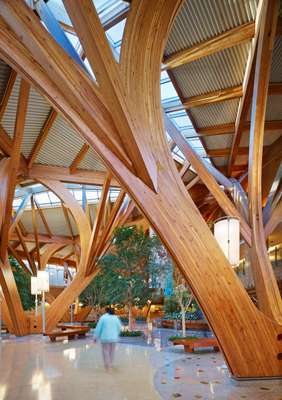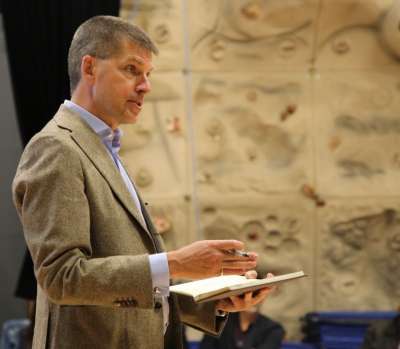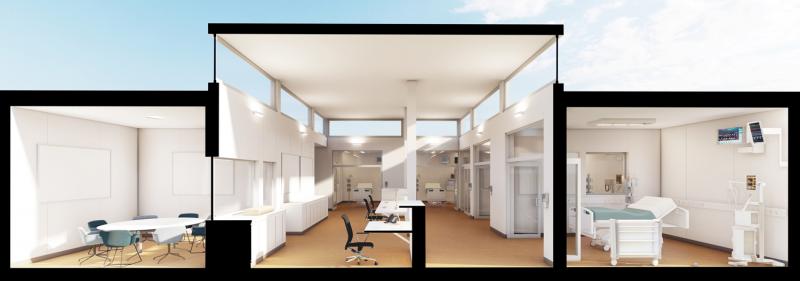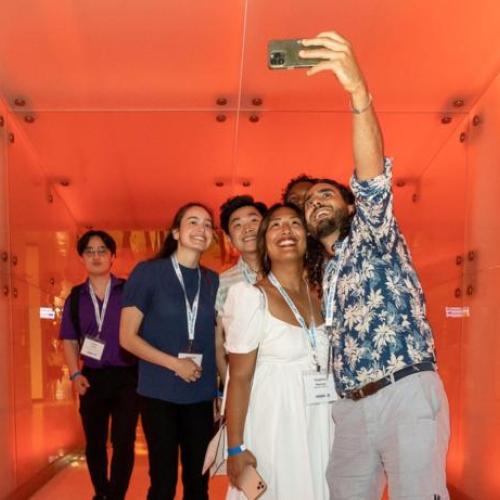April 29, 2020 | Alumni
Alumnus Tye Farrow designs temporary ICU units that help patients and workers feel more resilient

Architecture alumnus Tye Farrow (BArc 1987) is designing temporary ICUs that are not only quick and easy to build, but wrap health-promoting features into their very fabric. All images courtesy of Farrow Partners Architects
They went from a conversation on a Thursday morning to blueprints on Monday and a full-scale prototype built five days later. U of T alumnus Tye Farrow (BArc 1987) and U of T friend Ray Arbesman moved fast to design temporary intensive care units in a unique contribution to the global pandemic response.
The project, which includes a novel kind of building material as well as architectural designs, could soon be helping hospitals around the world.
Farrow, who is the senior partner at Farrow Partners, Inc. and the current president of the U of T Alumni Association, is an architect renowned for buildings that wrap health-promoting features right into their design. Arbesman is the founder of Nucap Industries, a global technology company, and the inventor of a new mechanical system to bind materials together safely. He is also a generous donor to U of T’s Factor-Inwentash Faculty of Social Work.
Together, they’ve developed Solace Rapid Assembly - High Performance COVID-19 Inpatient Bed Solutions. “Our goal has been to create solutions that are faster, cheaper, smarter, safer, more adaptable to individual hospital needs and importantly—healthier,” says Farrow.
“OUR GOAL HAS BEEN TO CREATE SOLUTIONS THAT ARE FASTER, CHEAPER, SMARTER, SAFER AND IMPORTANTLY—HEALTHIER”
Farrow founded the “Cause Health” movement to promote designs that nurture complete wellness, incorporating environmental sustainability, cultural sensitivity, a sense of purpose, and health-boosting features such as natural materials, fractal shapes, and sunlight.

For example, Farrow designed the Carlo Fidani Peel Regional Cancer Centre at Credit Valley Hospital in Mississauga with tree-like structures that evoke a person reaching their arms to the sky.
“Spaces can tune basic emotions and background bodily feelings from negative to positive,” he says. “Neurophysiologists call the principle ‘neural mirroring’—we model, or feel into, feelings we observe in another person.” A building environment creates a similar response, so the reaching up structures in the hospital actually generate optimism—as well as a sense of life and growth, and an uplifting feeling that you are somewhere special and purposeful.
Farrow is currently earning a master’s degree in Neuroscience applied to Architecture and Design—a field so specialized “I believe I will be the only architect in Canada with this degree,” he says. “There is scientific evidence that space can be an accelerant or leave us numb. And the human dimension connecting space and performance for medical staff and patients alike is at the top of my mind.”
AS LIGHT AS WOOD, AS STRONG AS CONCRETE, AS EASY TO ASSEMBLE AS LEGO
Farrow’s design for the ICU structures is based on an innovative, never-before used building technique: wood blocks laminated with metal instead of glue. Arbesman initially invented the fail-safe, velcro-like technology to build safer car brake pads, but the two began collaborating on possible construction uses about five years ago.

The resulting blocks are as strong as concrete—but lighter, and as easy to assemble as Lego. Even unskilled volunteers could build one of the 12-bed units on a parking lot or vacant lot in a few hours, says Farrow.
Features such as clestory windows to introduce natural light are designed to lower patient and staff stress, while the unit’s wraparound logistics corridor is environmentally controlled so that workers who service mechanics, electricity and medical gases remain reassuringly isolated from patient areas.
Farrow was inspired to improve on other temporary hospital solutions he’d seen on the news. “The environments we build to support our medical staff and patients need to be the meal equivalent to a fruit, vegetable and protein enhanced energy drink smoothie,” he says, “giving you mental energy and clarity, physical strength and resiliency and mind comfort; an accelerant that will help you succeed under stressed conditions.”
JURISDICTIONS IN CANADA, THE U.S. AND ISRAEL ARE ALREADY INTERESTED
Solace launched on April 23. “We already have interest from a range of different organizations in Canada, the US and Israel,” says Farrow. “People are looking at it for the Covid-19 ICU responses, but because it is ‘permanent in character’ yet can also be disassembled easily, jurisdictions are also looking at it for other related uses that will need a longer ‘shelf-life’ solution as we move into the winter.”
“I thought that the grip timber block solution was perfect as it could give a rapid response solution that could be designed to any medical special need, versus a fixed size as with shipping container structures,” he says. “And we can create an enhanced environment for staff and patients alike.
“Working on the project has been very stimulating and it’s satisfying that we will also be able to do our part.”


